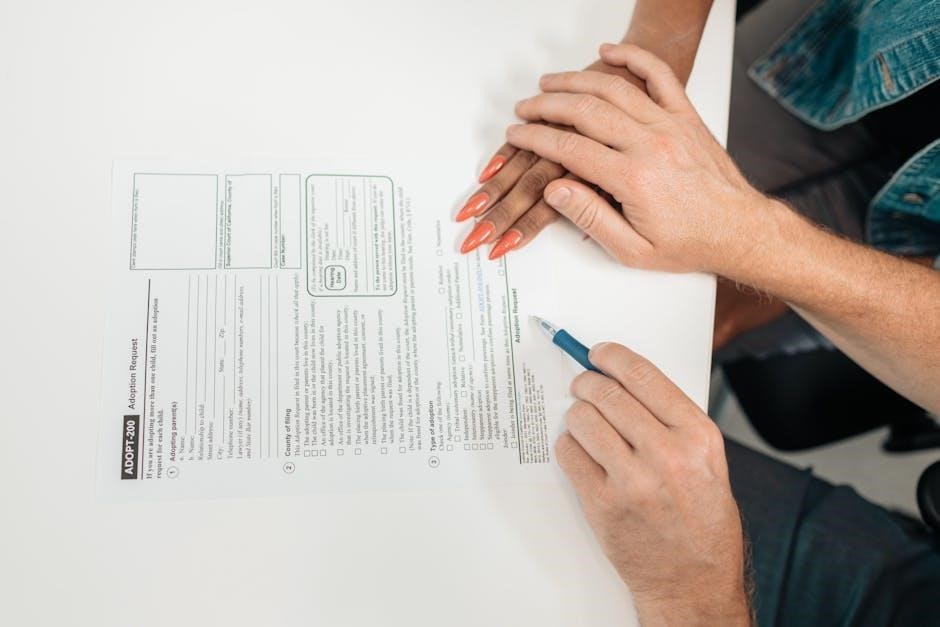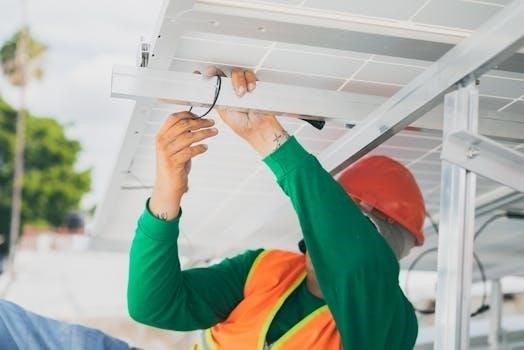Year 3 arithmetic tests are designed to assess students’ foundational math skills, focusing on mental arithmetic, problem-solving, and core numerical operations, aligning with curriculum standards.
Overview of Year 3 Arithmetic Tests
Year 3 arithmetic tests are structured assessments designed to evaluate students’ mathematical fluency and problem-solving skills. These tests typically cover a range of topics, including addition, subtraction, multiplication, and division, as well as word problems and number sequences. The questions are curated to align with curriculum standards, ensuring students are adequately prepared for further mathematical challenges. The tests are usually timed, with durations varying between 20 to 40 minutes, depending on the provider. They are often divided into sections, starting with straightforward calculations and progressing to more complex problems. The primary aim is to assess a student’s ability to apply arithmetic skills confidently and accurately, providing insights into their understanding and readiness for advanced concepts.
Importance of Arithmetic Tests for Year 3 Students
Arithmetic tests play a crucial role in Year 3 education, serving as a tool to gauge students’ progress in mastering essential mathematical skills. These assessments help identify strengths and areas needing improvement, enabling targeted support. Regular testing builds confidence and fluency in mental calculations, which are vital for everyday problem-solving. Additionally, arithmetic tests prepare students for standardized evaluations later in their academic journey, fostering a routine of practice and review. By reinforcing key concepts, these tests ensure a solid foundation for more complex mathematics in higher grades, making them an indispensable part of a student’s developmental process.
Purpose of Year 3 Arithmetic Tests

The primary purpose of Year 3 arithmetic tests is to evaluate students’ mastery of fundamental mathematical operations and their application in various contexts. These tests aim to assess the accuracy, speed, and problem-solving abilities of students, ensuring they meet curriculum expectations. By focusing on core skills such as addition, subtraction, multiplication, and division, the tests provide insights into students’ numerical fluency. Additionally, they help teachers identify learning gaps and tailor instruction to individual needs. Regular testing also fosters a routine of practice, reinforcing mathematical concepts and preparing students for future academic challenges. Ultimately, these assessments serve as a diagnostic tool to guide both teaching and learning effectively.

Structure of Year 3 Arithmetic Tests
Year 3 arithmetic tests typically consist of multiple-choice questions, fill-in-the-blanks, word problems, and number sequences, with a suggested duration of 30 minutes.
Format of the Test
The Year 3 arithmetic test is typically structured with multiple-choice questions, fill-in-the-blanks, and word problems. It is designed to assess mental arithmetic skills, with questions ranging from basic operations to more complex calculations. The test often includes a mix of numerical and word-based problems to evaluate a student’s ability to apply mathematical concepts in real-world scenarios. Some tests are divided into sections based on difficulty, starting with simpler questions and progressing to harder ones. The format may also include timed sections to encourage quick thinking and accurate responses. Resources like Y3-Arithmetic-Full-Test-1.pdf and similar documents provide examples of this structure, helping students and teachers prepare effectively for the assessments.
Types of Questions Included
Year 3 arithmetic tests typically include a variety of question types to assess different mathematical skills. Basic arithmetic operations like addition, subtraction, multiplication, and division are heavily featured. Word problems are also common, requiring students to apply math to real-life scenarios. Number patterns, sequences, and simple algebraic thinking are often included to challenge problem-solving abilities. Some tests incorporate mental math questions to evaluate quick calculation skills. Additionally, questions may involve interpreting data from charts or graphs, ensuring a well-rounded assessment of mathematical understanding. The mix of question types ensures that students are prepared for a range of challenges, from straightforward calculations to more complex, multi-step problems.
Duration of the Test
The duration of Year 3 arithmetic tests is typically 30 minutes, as suggested by various educational resources. This timeframe is designed to allow students sufficient time to complete the questions without causing undue stress. The 30-minute window ensures that students can demonstrate their understanding of arithmetic concepts, problem-solving abilities, and mental math skills. It also provides an opportunity for students to manage their time effectively, prioritizing tasks and reviewing answers if needed. This standard duration helps maintain consistency across different test papers and ensures fairness in assessment. The time limit is balanced to accommodate both quick calculations and more complex problems, allowing for a comprehensive evaluation of mathematical proficiency.
Scoring System
The scoring system for Year 3 arithmetic tests typically assigns one mark per correct answer, with no negative marking for incorrect responses. This approach encourages students to attempt all questions without fear of penalties. Each question is designed to assess specific arithmetic skills, ensuring a fair and transparent evaluation. The total marks vary depending on the number of questions, but most tests range between 20 to 40 marks. Detailed answer sheets are provided, allowing students and teachers to identify areas of strength and improvement. This system helps track progress and informs teaching strategies to address gaps in understanding. Consistency in scoring ensures equitable assessment across all students.

Key Content Areas in Year 3 Arithmetic Tests
Tests cover essential math skills, including addition, subtraction, multiplication, division, word problems, and number patterns, ensuring a solid foundation in numerical operations and problem-solving abilities.
Addition and Subtraction
Addition and subtraction form the core of Year 3 arithmetic tests, focusing on mental calculations and written methods. Students are expected to demonstrate proficiency in adding and subtracting multi-digit numbers, including regrouping. These questions often appear in word problems, requiring children to apply their understanding in practical contexts. The tests also include sequences that involve both operations, such as multi-step calculations. Fluency in these areas is crucial for building a strong mathematical foundation. Regular practice with worksheets and past papers helps students master these essential skills, ensuring they can tackle more complex problems with confidence in subsequent years.
Multiplication and Division
Multiplication and division are key components of Year 3 arithmetic tests, focusing on developing students’ understanding of these operations. Students are expected to recall multiplication tables up to 10×10 and apply them to solve problems. Division questions often involve sharing or grouping objects, with an emphasis on understanding remainders. These concepts are frequently tested through word problems and multi-step calculations. Practice papers and worksheets, such as Y3-Arithmetic-Full-Test-1.pdf and Y3-Arithmetic-Full-Test-2.pdf, provide ample opportunities for students to refine their skills. Mastery of these operations is essential for progressing to more complex math concepts in higher years.
Word Problems
Word problems in Year 3 arithmetic tests require students to apply mathematical skills to real-life scenarios, enhancing problem-solving abilities. Questions cover addition, subtraction, multiplication, and division, often involving money, time, and measurement. For example, calculating the total cost of items or determining the time taken to complete tasks. These problems assess the ability to interpret and translate written scenarios into mathematical equations, fostering logical reasoning. Practice papers like Y3-Arithmetic-Full-Test-3.pdf include diverse word problems, encouraging students to think critically and confidently. Regular practice helps students master this essential skill, preparing them for more complex challenges in higher grades.
Number Patterns and Sequences
Number patterns and sequences in Year 3 arithmetic tests help students develop logical thinking and problem-solving skills. These questions involve identifying and extending patterns, such as even and odd numbers, multiples, or sequences with a consistent difference or ratio. For example, students might complete a sequence like 2, 5, 8, 11, ___ or identify the next shape in a repeating pattern. Practice papers like Y3-Arithmetic-Full-Test-3.pdf include exercises that challenge students to recognize and predict patterns, fostering mathematical reasoning. Regular practice with number patterns prepares students for more complex problem-solving in later years, aligning with curriculum standards to build a strong foundation in numeracy.

Preparation Strategies for Year 3 Arithmetic Tests
Regular practice with resources like Y3-Arithmetic-Full-Test-1.pdf helps students master mental math and problem-solving techniques, building confidence and fluency in core arithmetic skills aligned with curriculum standards.
Tips for Students
To excel in Year 3 arithmetic tests, students should practice regularly using resources like Y3-Arithmetic-Full-Test-1.pdf and similar practice papers. Start with simpler questions to build confidence and gradually tackle more challenging problems. Dedicate time each day to mental math exercises, focusing on quick calculations. Review mistakes immediately after practice to understand and correct them. Use visual aids like number lines or counters to better grasp arithmetic concepts. Stay calm during tests, read questions carefully, and manage time effectively to complete all sections. Prioritize understanding concepts over rote memorization to ensure long-term mastery of arithmetic skills.
Role of Parents in Preparation
Parents play a crucial role in helping Year 3 students prepare for arithmetic tests. They can provide a supportive learning environment and encourage regular practice using resources like Y3-Arithmetic-Full-Test-2.pdf. Parents should engage in daily math activities with their children, such as solving problems together or using real-life scenarios to practice arithmetic. They can also monitor progress by reviewing completed practice papers and offering constructive feedback. Staying in communication with teachers ensures alignment with curriculum goals. Parents should foster a positive attitude toward math, celebrating small achievements to build confidence. By making learning interactive and fun, parents can significantly contribute to their child’s success in arithmetic tests and overall academic development.
Teacher’s Guide to Effective Preparation
Teachers play a vital role in preparing students for Year 3 arithmetic tests by providing structured and engaging lessons. They should begin by identifying key areas of focus, such as mental math, addition, subtraction, multiplication, and division, ensuring alignment with curriculum standards. Utilizing resources like Y3-Arithmetic-Full-Test-1.pdf and Y3-Arithmetic-Full-Test-2.pdf can help simulate test conditions and familiarize students with the format. Teachers should incorporate regular practice sessions, breaking problems into smaller steps to build confidence. Encouraging peer discussions and group activities can also enhance understanding. Providing timely feedback and tracking progress through practice papers helps teachers tailor instruction to meet individual needs. By creating a supportive and structured learning environment, teachers can effectively prepare students for success in their arithmetic tests.

Sample Test Papers and Resources
Access practice materials like Y3-Arithmetic-Full-Test-1.pdf, Y3-Arithmetic-Full-Test-2.pdf, and additional resources to help students prepare effectively for their arithmetic assessments.
Year 3 Arithmetic Practice Papers
Year 3 arithmetic practice papers are essential resources for students to refine their math skills. These papers, such as Y3-Arithmetic-Full-Test-1.pdf, Y3-Arithmetic-Full-Test-2.pdf, and Y3-Arithmetic-Full-Test-3.pdf, cover a wide range of arithmetic topics. They include questions on addition, subtraction, multiplication, and division, as well as word problems and number patterns. Designed to align with curriculum standards, these papers help students build confidence and fluency in mental and written calculations. Many resources, like those from Twinkl and Testbase, offer structured tests with answer sheets for easy marking. Teachers and parents can use these papers to identify areas where students may need extra support. Regular practice with these materials ensures students are well-prepared for formal assessments and develops their problem-solving abilities.
Y3-Arithmetic-Full-Test-1.pdf
Y3-Arithmetic-Full-Test-1.pdf is a comprehensive practice paper designed for Year 3 students to assess their arithmetic skills. This test includes 27 questions covering essential math operations such as addition, subtraction, multiplication, and division. It aligns with the National Curriculum objectives, focusing on foundational numeracy and problem-solving abilities. The paper is structured to gradually increase in difficulty, ensuring students can apply their knowledge confidently. Questions are presented in a clear format, with space for written calculations. An accompanying answer sheet allows for easy marking and feedback. This resource is ideal for regular practice, helping students identify strengths and areas for improvement while preparing for formal assessments. Teachers and parents can use it to monitor progress and provide targeted support.
Y3-Arithmetic-Full-Test-2.pdf
Y3-Arithmetic-Full-Test-2.pdf is the second practice paper in the series, designed to further develop Year 3 students’ arithmetic skills. This test includes 30 questions, focusing on key areas such as addition, subtraction, multiplication, and division, while introducing word problems and number sequences. The questions are structured to start with straightforward calculations and progress to more challenging problems, allowing students to build confidence and fluency. The test aligns with the National Curriculum and is ideal for regular practice. It includes a clear layout and space for written calculations. The accompanying answer sheet provides detailed solutions, enabling students and educators to track progress effectively. This resource is perfect for reinforcing math concepts and preparing students for formal assessments. Regular use helps identify areas needing additional support, ensuring a solid foundation in arithmetic.
Y3-Arithmetic-Full-Test-3.pdf
Y3-Arithmetic-Full-Test-3.pdf is the third installment in the Year 3 arithmetic practice series, offering 27 carefully crafted questions to challenge students. This test emphasizes mental math and multi-step calculations, with a focus on mixed operations and word problems. Designed to build on the skills assessed in previous tests, it introduces slightly more complex scenarios, such as calculating totals with money and solving simple algebraic patterns. The questions are arranged to gradually increase in difficulty, allowing students to apply their knowledge confidently. A detailed answer sheet is included, providing correct answers and explanations for each question. This resource is ideal for reinforcing arithmetic fluency and preparing students for more advanced math concepts in higher grades. Regular practice with this test helps students master essential skills and identify areas for further improvement.
Y3-Arithmetic-Full-Test-4.pdf
Y3-Arithmetic-Full-Test-4.pdf is the final practice paper in the Year 3 arithmetic series, featuring 30 challenging questions tailored to advanced learners. This test focuses on complex arithmetic operations, including multi-digit calculations, mental math challenges, and real-world word problems. It is designed to refine students’ problem-solving skills and ensure mastery of Year 3 curriculum objectives. The questions are structured to assess both speed and accuracy, with a mix of straightforward calculations and more intricate scenarios. An accompanying answer sheet provides detailed solutions, enabling students to review and improve their performance. This resource is particularly useful for students nearing the end of Year 3, helping them consolidate their knowledge and prepare for higher-level mathematics in subsequent years. Regular use of this test fosters confidence and arithmetic fluency.

Difficulty Levels and Progression
Tests include easy, medium, and hard questions, ensuring progression from basic arithmetic to complex problems, aligned with curriculum standards for Year 3 students’ development.
Easy, Medium, and Hard Questions
Year 3 arithmetic tests are structured to include a mix of easy, medium, and hard questions to cater to varying skill levels. Easy questions focus on basic arithmetic operations like addition and subtraction, ensuring students grasp foundational concepts. Medium questions introduce multi-step problems, such as combining addition and subtraction or simple multiplication and division, to build problem-solving skills. Hard questions challenge students with complex word problems and mental arithmetic, requiring deeper understanding and application of concepts. This progression ensures comprehensive assessment of students’ abilities, helping teachers identify strengths and areas needing improvement. The varied difficulty levels also encourage incremental learning, preparing students for higher-level math in subsequent years.
Progression Through Difficulty Levels
Year 3 arithmetic tests are carefully designed to ensure a smooth progression through difficulty levels, allowing students to build confidence and skills gradually. The tests begin with straightforward questions focusing on basic arithmetic operations, such as simple addition and subtraction, to ensure foundational understanding. As students progress, questions become more challenging, incorporating multi-step problems and mental arithmetic. This structured approach helps students transition seamlessly from basic to advanced concepts, fostering a deeper understanding of numerical operations and problem-solving strategies. The progression aligns with curriculum standards, ensuring students are well-prepared for future math challenges. By introducing complexity incrementally, these tests support individual learning pacing and readiness for higher-level mathematics in subsequent years.

Common Mistakes and Solutions
Common mistakes include calculation errors, misreading questions, and rushing through problems. Solutions involve careful reading, checking work, and using visual aids to clarify complex arithmetic tasks.
Identifying Common Mistakes
Common mistakes in Year 3 arithmetic tests often stem from rushed calculations, misreading questions, or misunderstanding operands. Students may struggle with place value, miscalculating additions or subtractions, especially with regrouping. Multiplication and division errors frequently occur due to incorrect multiplication tables recall or improper sharing and grouping strategies. Word problems are another challenge, as pupils may misinterpret the context or fail to apply the correct operation. Additionally, number patterns and sequences sometimes confuse students, leading to incorrect continuations. Teachers and parents can identify these mistakes by reviewing test papers, observing problem-solving approaches, and providing targeted feedback to address these areas effectively.

Strategies to Correct Mistakes
To correct mistakes, students should first review their work to identify errors, ensuring they understand the problem. Breaking problems into smaller steps can simplify complex tasks, reducing the likelihood of miscalculations. Utilizing visual aids like number lines or counters helps in grasping abstract concepts. Practicing multiplication tables regularly can improve recall and accuracy. For word problems, teaching children to underline key information and identify the operation needed enhances comprehension. Encouraging the use of inverse operations to check answers is another effective strategy. Providing structured feedback and positive reinforcement helps build confidence and persistence, fostering a growth mindset and encouraging students to approach challenges with determination.
How to Avoid Common Errors
To avoid common errors in Year 3 arithmetic tests, students should adopt systematic approaches to problem-solving. Encouraging the use of number lines or counters can help visualize calculations, reducing mistakes. Regular practice of multiplication tables enhances speed and accuracy, minimizing errors during tests. Teaching children to underline key information in word problems aids in identifying the correct operation. Using inverse operations to verify answers is an effective checking method. Providing clear, structured feedback and positive reinforcement builds confidence and helps students learn from their mistakes. Consistent daily practice reinforces good habits and reduces errors. Parents and teachers should foster a supportive environment where mistakes are viewed as learning opportunities, promoting a growth mindset and careful problem-solving strategies.

Test Results and Interpretation
Understanding test results helps identify strengths and weaknesses, guiding targeted support and teaching strategies to enhance Year 3 students’ arithmetic skills effectively.
Understanding the Results
Understanding the results of Year 3 arithmetic tests is crucial for identifying student progress and areas needing improvement. The results typically include marks, correctness rates, and time management insights. By analyzing these, teachers and parents can pinpoint strengths, such as quick mental math skills, and weaknesses, like difficulty with multi-step problems. The results also highlight gaps in understanding specific concepts, such as subtraction or multiplication facts. This data helps tailor support, ensuring targeted practice and review. Over time, tracking results reveals progress, motivating students to build confidence and mastery. Clear interpretation of results is essential for fostering a growth mindset and preparing students for future academic challenges in mathematics.
Monitoring Progress
Monitoring progress in Year 3 arithmetic tests involves regularly tracking students’ performance to identify improvement areas and strengths. Teachers use test results to compare scores over time, highlighting growth in mental math, problem-solving, and numerical accuracy. Parents can also review progress reports to support their child’s learning journey. By analyzing consistent strengths, such as quick recall of multiplication facts, and persistent weaknesses, like multi-step word problems, targeted interventions can be implemented. Progress tracking helps adjust teaching strategies, ensuring students build confidence and mastery. Regular monitoring also reveals patterns in learning, guiding differentiated instruction and celebrating small achievements. This ongoing assessment is vital for fostering a growth mindset and preparing students for future academic challenges in mathematics.
Using Results to Inform Teaching
Arithmetic test results provide valuable insights for teachers to tailor their instruction effectively. By analyzing individual and class performance, educators can identify strengths and areas needing improvement. For instance, if many students struggle with multi-digit subtraction, additional lessons or alternative teaching methods can be implemented. Results also help differentiate instruction, ensuring all learners receive appropriate challenges. Teachers can modify lesson plans to address specific gaps in understanding, such as introducing more visual aids for students who find word problems challenging. Regularly reviewing test data allows educators to track progress, celebrate successes, and make data-driven decisions to enhance learning outcomes. This approach ensures that teaching strategies remain aligned with student needs and curriculum goals, fostering a more effective and engaging learning environment.








































